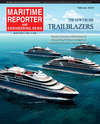
Page 50: of Maritime Reporter Magazine (February 2018)
Cruise Ship Annual
Read this page in Pdf, Flash or Html5 edition of February 2018 Maritime Reporter Magazine
Zero Emission Shipping
Meets High-Level Sports
MARIN’s research work in Wind (Assisted) Ship Propulsion and our mission to make ships cleaner, safer and smarter is all coming into play as they assist team AkzoNobel with their Volvo Ocean Race challenge.
BY ROGIER EGGERS
Image Courtesy MARIN
ARIN’s research Wind propelled model • ReFRESCO Computational Fluid Added value in ‘raw’ resistance work in Wind (As- For this purpose a set-up was devel- Dynamics simulations (RANS) in calm In this project MARIN pushed the sisted) Ship Propul- oped to model wind propelled vessels in water, to have calculations with the best boundaries through extensive seakeep- sion and our mission MARIN’s Seakeeping and Manoeuvring possible accuracy. At the same time, ing tests and simulations, which also ac-
M to make ships cleaner, Basin to perform a short validation, these calculations are too costly and count for added resistance. A dedicated safer and smarter is all coming into play model test programme. This was fol- time consuming to span all operational test set-up and carbon model was built as they assist team AkzoNobel with their lowed by a more extensive calculations’ parameters. to achieve a low weight of 90 kg with a
Volvo Ocean Race challenge. programme supported by the validation • PANSHIP potential ? ow simula- length of just under 4 m, while having
Over the years MARIN has had some data. In this way we provided valuable tions in calm water to extend the param- the (approximate) correct stability, right- very successful involvement with rac- input to the sailors, while the set-up, cal- eter space covered by the ReFRESCO ing moment and inertia at the same time. ing sailing yachts. One example was the culation methodologies and the lessons simulations (after a comparison with the During the tests the canting keel could support for the Australia II team that was learned are applicable for wind-assisted ReFRESCO results) be set to various angles and the rudders the ? rst non-US team to win the Ameri- cargo ships as well. • Scale model tests in waves to deter- were actively controlled by an autopilot. cas Cup. Another more recent example is It should also be noted that the Volvo mine the performance, and in particular A moveable horizontal beam was ? tted the ABN AMRO team winning the Vol- Ocean 65 is a ‘one-design boat’. The the added resistance in waves (RAW). on the two masts to change the connec- vo Ocean Race when canting keel boats team receives the boat from the race or- Again, due to cost this is only done for a tion point of the winch set-up. In this were ? rst introduced. Now the AkzoNo- ganisation and is not allowed to make small number of conditions. way the aerodynamic centre of effort bel team, skippered by Simeon Tienpont, changes. This means that the predictions • PANSHIP simulations in waves to could be varied in a large range of longi- has approached MARIN to support them cannot be used for design changes, so extend the parameter space as covered tudinal and vertical locations.
as they enter the Volvo Ocean Race. you may well ask what the predictions by the model tests. In the winch set-up lines were used to
This time, the research ? ts in a different are for? First of all, the crew still has • Onboard monitoring to validate the apply the aerodynamic loads from the context and involves our work in Wind many different ways to sail the boat in simulations and determine if and where sails. The required driving force was (Assisted) Ship Propulsion (WASP). the fastest possible manner. And because corrections need to be made to the labo- recalculated each time-step, accounting
It supports our long-term objective for training days are limited, they will not ratory” experiments. for the following instantaneous values: “cleaner” ships and the development of encounter all the conditions they will • Additionally, work is planned to cal- • Apparent wind angle over deck zero- emission shipping, not only for face during the race to check and opti- culate the actual wave conditions based • Apparent wind speed over deck sailing yachts but for merchant ships as mise their performance in practice. This on the measured motions on board. This • Heel well. is precisely why the predictions are will help the crew decide on which added • Roll velocity (estimate for roll
A speci? c ? eld of research that receives used - to have a benchmark, or starting resistance (and associated performance) damping) relatively little attention, both in wind- point for the best setting for each con- is applicable at that moment. Further- The winches were controlled based assisted cargo ships and sailing yachts, dition. Furthermore, besides sailing fast, more, the actual conditions may be used on the required driving force. By using is the impact of real operational condi- you should sail the best route. The work to benchmark the metocean forecasts to two winches, the force vector can move tions in wind and waves. Therefore, we MARIN is conducting will give insight further optimize the routing. in any direction between them. This ac- decided to focus our research and added into the performance in waves, which The team itself complemented the counts for diversions in course, speed value for Simeon’s team on determining should lead to better routing decisions. above with performance analysis of all and unexpected heel angles. As far as we the performance of his yacht in real op- To this end, the following work is car- the training, preparatory races and crew know this set-up is unique in the world.
erational conditions. ried out: monitoring. Applications for wind-assisted ships in 50 Maritime Reporter & Engineering News • FEBRUARY 2018
MR #2 (50-57).indd 50 MR #2 (50-57).indd 50 2/8/2018 9:58:50 AM2/8/2018 9:58:50 AM

 49
49

 51
51
